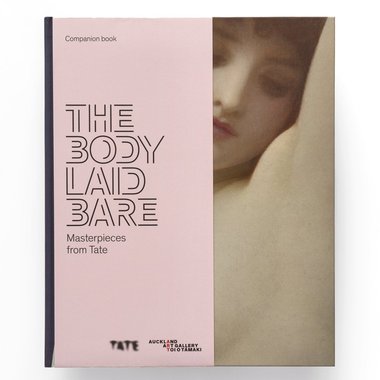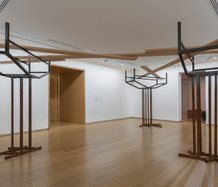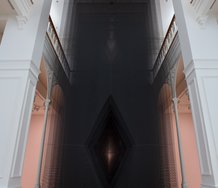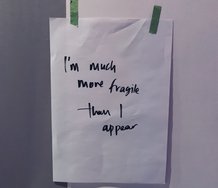Terrence Handscomb – 26 April, 2017
Actual sexual encounters usually involve nakedness and a lot of tactility, so if Debord's contention is true, then in the twenty-first century the primacy of visuality over touch must have a significant impact on the ways in which unclothed bodies are socially considered. Naked bodies are represented in a number of visual milieux but it is the extensive reach of internet pornography across age and gender differences that is perhaps the most significant.
Nude: Art from the Tate Collection
Emma Chambers and Justin Paton
223 pages
Illustrations (chiefly colour)
Published by the Art Gallery of New South Wales, Sydney, 2016
This is the companion book to the touring exhibition The Body Laid Bare: Masterpieces from Tate, currently being presented at Auckland Art Gallery Toi o Tāmaki (18 March 2017-16 July 2017). Despite the image above with its temporary ‘marketing’ cover-slip, the book’s title is different from that of the Auckland show.
The curatorial logic for The Body Laid Bare: Masterpieces from Tate (hereafter denoted TBLB) is tightly bound by the straightjacket of comparative art history, as institutional art collections tend to be. The historical reach of the exhibition therefore, does not quite reach the cultural condition whereby, in the age of the internet, the representation of nudity has become a highly sexualised spectacle.
French philosopher Guy Debord believed the spectacle to be the insidious face of capital (1). Debord’s theory of the society of the spectacle was an anti-capitalist censure that informed much of the rhetoric of the 1968 Paris student uprisings, but it also presaged the emergence of capital’s most effective weapon: electronic media and the internet. Because the human interface with electronic media is mainly visual, it is inevitable that the spectacle ‘should elevate the human sense of sight to a special place once occupied by touch.’ (ibid. thèse 18)
Actual sexual encounters usually involve nakedness and a lot of tactility, so if Debord’s contention is true, then in the twenty-first century the primacy of visuality over touch must have a significant impact on the ways in which unclothed bodies are socially considered. Naked bodies are represented in a number of visual milieux but it is the extensive reach of internet pornography across age and gender differences that is perhaps the most significant.
In the twenty-first century, the visual semiotics of nakedness has been so smothered by new technology that the hallowed ground upon which the academic nude once lay has been so infected by these seeds, that one would think that a major exhibition of nude and naked bodies like TBLB would provide the perfect critical milieu to at least approach, let alone fully explore, this condition. To a certain extent the exhibition approaches this critical edge (the inclusion of Carolee Schneemann’s Interior Scroll (1975) as an illustrated collection item in Chambers’ essay - but not exhibition - attests to this), but it quickly fades at the forensic limits of art history, which for TBLB, is the late 1990s.
Because TBLB showcases a tasteful and important Tate collection, its curatorial path has not wandered too far from the moral edge of public acceptability and the boastful safety of self-admiration that always seems to accompany big flashy shows. When a work of art enters the public domain, its semiotic meaning is up for grabs. This is also true of curatorial endeavors like TBLB.
Because it is the principal publication for TBLB, The Nude: Art from the Tate Collection has an added paper cover-slip that describes the publication as the ‘companion book’ for the show. To be specific, it has two curatorial essays, one each by the two curators that assembled TBLB: ‘Flesh and form: redefining the nude in the twentieth century’ by Emma Chambers (pp 14-19) and ‘Body language: notes on the painted nude’ by Justin Paton (pp 22-29).
As curatorial writers, Chambers is the more eloquent. Her careful art-historical unpacking of the show contrasts with Paton’s alacritous but slightly patronising Art History 101 pedagogical style. Despite how chuffed Paton appears to be with his significant personal curatorial achievement, he is smart enough to deflect this back upon the work. Paton: TBLB provides ‘… an opportunity to encounter [exceptional] artworks in the flesh: to meet and measure ourselves against these insistently physical bodies’ (op cit p 23). It is difficult to disagree when considering, for example, Stanley Spencer’s (1891-1959) courageous and contentious painting Double nude portrait: the artist and his second wife (1937, pp 118-19) or Sylvia Sleigh’s (1916-2010) audacious painting Paul Rosano reclining (1974, pp 164-65). TBLB includes some truly great works, the likes of which are rarely seen in New Zealand and this in itself is worth lauding.
Indeed, TBLB is a lot more than a blockbuster spectacle wrapped in introjected Tate vanity. The show is so replete with accomplished art that any residue of what might be called curatorial interference is not enough to prevent the art from “speaking for itself,” to paraphrase Paton.
That art could speak for itself is of course a poetic fallacy. Ignoring any lingering remnant of modernist discourse, there is no immanent power embedded in an art object and certainly not enough for it to speak. As I see it: art, and especially great art, evokes a sort of instinctual solipsism that loops between the viewer and themselves, thereby creating a (momentary) viewing subject that does all the speaking (2).
Great art will evoke new subjectivities - albeit solipsistic ones - but humans are a notoriously fickle lot and the life of such subjectivities can be extremely short-lived.
•••••
Straight up front, in the first line, in the first sentence of the first paragraph of his recent book Bad New Days, American art critic and historian Hal Foster (famous in the 1980s) satisfyingly proclaims: ‘Contemporary art is so vast, so diverse, and yes, so present as to frustrate any historical overview…’ (Bad New Days: art, criticism, emergency, London: Verso, 2015, p 1). Despite the difficulties art history faces when trying to make sense of the whole contemporary art shebang, coherent notions do exist. One task that criticism faces is to ‘… articulate such terms as best it can’ (ibid) and move on from historical postmodernism with its ‘privileging of the imagistic and the textural toward a probing of the real and the historical’ (ibid, my emphasis).(3) Foster does provide a few key phrases that may help point the way: abject, archival, mimetic, precarious, post-critical - one for each chapter of his book, although I still have no idea what post-critical means.
But what better way to get real than to get naked? Herein lies a critical problem that has lodged itself firmly in the gap between real and historical. When it comes to the representation of human nakedness, how close can TBLB comfortably approach the allegorical gap between the culturally insulated principles of art and the ‘morally bankrupt aberrance’ of in-your-face nakedness without falling into the cultural abyss of explicit pornography?
Chambers explains the critical difference between the nude and the merely naked. The difference is deeply emblematic. She exhumes the influential views of mid-century British art-historian Kenneth Clark (1903-1983) who, in channeling the vestal dignity of the Dresden Venus (aka Giorgione’s Sleeping Venus (1508-10) pompously asserts: ‘to be naked is to be deprived of our clothes’ but ‘the nude remains the most complete example of the transmutation of matter into form.’ (4) Furthermore, ‘… works in which the model displayed too much individuality or conveyed too much overt sexuality were dubbed by him [Clark] to be naked rather than nude.’ (5)
Yet Stanley Spencer’s wretched family portrait - or even John Coplans’ Self-portrait (frieze no 2, four panels) (1994) pp 178-79 - sidesteps Clark’s narrowness by injecting a pathology of self-effacing realism into the visual mix that emotionally redefines what it means to be naked. Stanley’s great painting was produced at a time when two horrific world wars and a secular psychoanalytical world view were in the process of severely corroding the sort of religiosity which informed Clark’s pompous transcendentalism, which Stanley’s puissant carnal realism affectively occludes.
For the most part, the solo naked figures in TBLB lie in postures of benign passivity; consider Sleigh’s Paul Rosano reclining and Barkley Hendricks’ hilariously titled Family Jules: NNN (No Naked Niggars) 1974, pp 166-67). Although The erotic nude section of TBLB and The Nude both have a couple of works depicting couples having actual or implied sex, they are nevertheless benign by current cultural standards. Even the aesthetically pure form of Auguste Rodin’s fabled The kiss (Le basier) 1901-04 (p 143) shows a male figure deep in erotic embrace but the work avoids the ignobility of being too explicit - the male figure has no hard-on, although his pubic hair is tastefully rendered.
When naked bodies are sexualised - which is what usually happens when we take our clothes off - and when serious art becomes sexually explicit and the fickle shifting boarders of good taste are easily breached, then ‘sexual morality is undoubtedly a political issue’ (Chambers p 18).
Recall the art-world outrage, when in the early 1990s famed American artist Jeff Koons followed his obsession with fabled Hungarian-Italian porn-star and politician Cicciolina (aka Ilona Staller) and made Made in Heaven (1990-91). After seeing Staller pictured in the German magazine Stern in 1988 (6), Koons wrote to her, married her and explicitly fucked her in front of the camera and called it art. Made in Heaven included explicit large grainy photographs printed on canvas, glassworks, and sculptures of Koons and Staller having sex. When it first appeared Made in Heaven provoked considerable controversy in the art world and reaction against Koons was swift. The mainstream art establishment distanced itself from Made in Heaven and decried its visceral animalité. With individual titles like Jeff Eating Ilona (Kama Sutra), Dirty - Jeff On Top, Dirty Ejaculation and Ilonaʼs Asshole, the so-called travesty was widely considered to be a ‘horrifyingly unguarded, emotionally raw, and sexually explicit’ artistic blunder (Carl Swanson, New York Magazine, May 13, 2013). Eventually, ‘in a fit of disappointment and self-loathing’ Koons destroyed many of his Made in Heaven pieces. ‘He had exposed himself, and been humiliated (ibid).’ (7)
Recall also porn actor Dolly Sharp playing cigarette-smoking Helen in Gerard Damiano’s porn-classic-sex comedy Deep Throat (1972, 61 mins). In one memorable oral sex scene, Helen looks down at her very hairy pussy and comically asks her muff-munching partner: ‘Do you mind if I smoke while you’re eating?’ Dolly’s ad lib minor virtuosity was probably linked to the fact that Dolly Sharp was the porn name of Juilliard-trained violin child prodigy and Broadway and Hollywood actor Helen Wood (1935-98). Wood first agreed to appear in Deep Throat in the mistaken belief that the film would be seen by an extremely small audience. Sharp’s acting career stumbled and she quickly fell into obscurity. Her brief porn appearance all but ruined her chances of acting again on Broadway and in mainstream cinema.
These two stories are homiletic but they do emphasise the keen allegorical divide between pornography and high art and how difficult it can be for artists to navigate the shifting margins of cultural acceptance; especially if their work entails explicit sexuality. Even famous French psychoanalytical theorist Jacques Lacan percipiently observed, when it comes to visuality and desire ‘in the matter of the visible, everything is a trap.’ (8)
Having said this, however, the in-your-face crudity of Carolee Schneemann’s defiant live-action-cum-interventionist-performance Interior Scroll threatens to cripple this sort of thinking. Unlike Koons’ Made in Heaven, Schneemann’s work is a testament to an artist who, despite the abject content of her work, successfully navigated the shifting quicksands of art-world acceptance. Interior scroll famously pictures Schneemann pulling a scroll of paper from her (very hairy) vagina. Yet, as part of the Tate collection, Interior Scroll has been culturally insulated by the intellectual seriousness that art-history affords works of art that make their way into major institutional collections. This is enough to separate the explicit nudity of Interior scroll from that of base viscerality.
Because Schneemann was not pictured having sex with anyone a la Koons, the critically of the work was not eroded and was easily elevated beyond the reach of rudimentary moralising. Although Schneemann’s Interior Scroll was met with feminist hostility when it first appeared, British art historian Lisa Tickner defended the work by arguing that works like Interior Scroll ‘were beginning to shift existing paradigms [even] as they worked within them.’ (9) Although Interior Scroll was first performed and documented in East Hampton, New York in 1975, it was not presented to Tate Modern until 2012, almost thirty-seven years later.
•••••
The dominant curatorial concern of TBLB is the art historical showcasing of a major institutional collection. However, the show unintentionally provides an insight into contemporary visual culture, albeit tangentially. The contemporary cult of pubic hairlessness amongst women exhibits many of the same visual characteristics as the classical academic female nude. Now well into the twenty-first century, the widespread practice by which women, especially younger women, regularly shave, wax off or laser away their pubic hair, mimics the same smooth visual properties as the classical female nude, but without its vestal modesty.
Undoubtedly, pubic follicle waxing is a highly sexualised body-aesthetic and the practice has spawned remarkable new visual codes that determine how the sexualised female body should now appear. This is also true of men, but to far less extent. When it comes to time and taste, visual history can play delightful games. Silvia Sleigh’s Paul Rosano is very hairy. Lying back in full repose and replete with full body hair rendered in resolute brush strokes, Paul looks like a cute Ron Jeremy with a 1970’s Latin-white-boy afro. Added to this is a wistful sexuality whereby Paul’s goofy facial expression suggests that he would go with just about anyone who was nice to him. I’ve also heard anecdotally that the abundant all-over body hair and portly physicality of aforementioned 1970s and 1980s porn actor Ron Jeremy - he has reputedly appeared in over 2,000 porn films - has generated a vexatious condition whereby some Generation X women remain unable to purge reoccurring phantasies of sex with dirty old men, a condition abhorrent to many young women. Most present-day male porn actors are severely body-waxed.
Nevertheless, the new hairless body laid bare awakens the old Lacanian idea that the migration of conscious desire passes from the specular to the imaginary and then from the imaginary to the symbolic.
Objects of desire are easily bound by the symbolic laws and moral codes that shape human behaviour. This becomes problematic when dated tokens of desire (hairy pussy) are not discarded and new ones (shaven pussy) allowed to take their place. This is also true of embarrassing phantasies of having sex with Ron Jeremy. Indelible images from the past can always occlude the symbolic laws that seek to moderate desire and when this happens, resistance is inevitable.
Putting this another way: to many men (and women, I suppose), hedgehog Barbie is not a cute look, nor is it a nice touch, and TBLB sparks a quirky reminder of the extent to which personal taste can change, especially when it comes to the visual politics of human nakedness.
Terrence Handscomb
(1) Guy Debord: ‘The spectacle is capital accumulated to the point where it becomes image’ (La société du spectacle, Paris: Buchet-Chastel, 1967, thèse 34).
(2) This is a play on Lacan’s line from his famous seminar on the gaze: Mais moi, je suis dans le tableau. (Seminar XI, (Paris: Seuil, 1973). Sheridan translates this as: ‘The picture, certainly, is in me. But I am not in the picture.’ (The four fundamental concepts of psychoanalysis trans. Alan Sheridan, London: Hogarth, 1977, p 96). Foster objects by reversing the polarity of the gaze while noting that Sheridan, for unknown reasons, incorrectly translated the line. Foster thinks the sentence should read:‘No doubt, in the depth of my eye, the picture is painted. The picture, certainly, is in my eye. But I, I am in the picture’ (Foster 2015, p 9). Indeed, my solipsistic view of the gaze requires that Lacan’s ‘subject of representation’ is in the work and that furthermore ‘I turn myself into a picture under the gaze’ (Lacan, op cit p 106).
(3) With some irony Foster views demonstrate the importance he gives to moving on from the critical trust of his celebrated book The Post-Modern Condition (1985), his once ground-breaking compendium of essays by some of critical theory’s great thinkers from the 1980s.
(4) Chambers p 14, quoting Kenneth Clark, The nude: a study of ideal art, London: Penguin Books Ltd, Harmondsworth, 1956, pp 1, 23.
(5) ibid Chambers p 15.
(6) cf. Ingrid Sischy,’Koons, High and Low’, Vanity Fair uploaded October 3, 2007;
http://www.vanityfair.com/culture/2001/03/jeff-koons-200103.
(7) Despite the widespread negative reaction to Made in Heaven, Koons quickly exonerated himself the way he does best: by making more art. With deft political nous, he produced a giant floral puppy which he installed on the fringes of Documenta IX in Kassel in 1992. The artistic director was Belgian impresario Jan Hoet whose anti-commercial rhetoric would have been contradicted if he had chosen Koons for the quinquennial. According to some critics, Puppy should have been installed in a place of honour in front of the Museum Fridericianum, the main building that houses Documenta. As American art critic Peter Schjeldahl cynically noted: Puppy ‘should have been in Documenta fronting the Fridericianum, where it would have both called the bluff and upped the ante of a more evasively condescending game played by Hoet’ (‘The Documenta of the Dog,’ Art in America, Sept. 1992, pp. 88-97, 77). With this timely punch-back, Koons effectively transcended the political fallout from Made in Heaven, much to the chagrin of his adversaries.
(8) Le Sèminaire de Jacques Lacan, Livre XI, 4 mars 1964; Sheridan trans., London: Hogarth Press, 1977, p 92.
(9) Lisa Tickner, ‘The body politic: female sexuality and women’s artists since 1970’ Art History, vol 1, no 2, June 1978, p 247; quoted by Chambers p 19.

 Advertising in this column
Advertising in this column Two Rooms presents a program of residencies and projects
Two Rooms presents a program of residencies and projects



This Discussion has 0 comments.
Comment
Participate
Register to Participate.
Sign in
Sign in to an existing account.